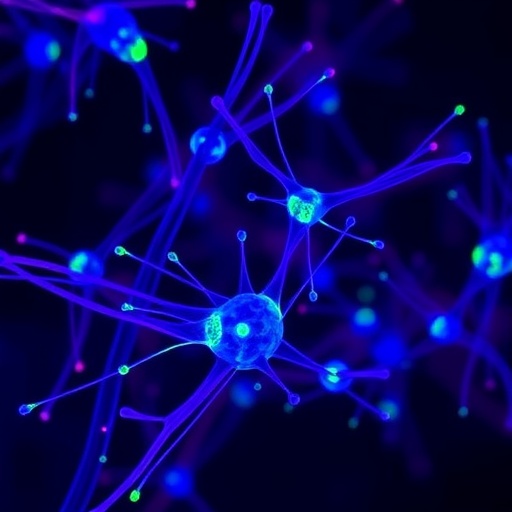In a groundbreaking study published in Nature Communications, researchers have unveiled a novel epigenetic mechanism driving psoriasis progression, revealing unexpected intricacies in inflammatory signaling within the skin. This discovery centers on the role of keratinocyte-specific histone lactylation at lysine 12 on histone H4 (H4K12la), which orchestrates a previously unrecognized, non-canonical interleukin-17 (IL-17)-dependent pathway in a murine model of psoriasis. The findings illuminate crucial connections between metabolic reprogramming and immune dysregulation, opening new avenues for targeted therapeutics in chronic inflammatory skin disorders.
Psoriasis, a common and debilitating autoimmune skin disease, arises from complex interactions between keratinocytes and immune cells. Classical models emphasize the pivotal functions of IL-17 cytokines secreted predominantly by Th17 cells in sustaining skin inflammation and hyperproliferation of keratinocytes. However, the exact molecular underpinnings integrating cellular metabolism, chromatin remodeling, and cytokine signaling within keratinocytes have remained largely unexplored until now. The current investigation leverages cutting-edge epigenomic and molecular biological methodologies to bridge this knowledge gap.
Central to the study is the identification of lactylation—a newly characterized post-translational modification of histones—as a key epigenetic mark modulating keratinocyte function. Histone lactylation, induced by high intracellular lactate levels typical in inflamed tissue microenvironments, was found to specifically enrich at the H4K12 residue within epidermal keratinocytes during psoriatic lesions. This modification appears to act as a metabolic sensor that translates shifts in cellular metabolism into durable changes in chromatin accessibility, thereby regulating gene expression programs relevant to inflammation.
Through the use of genetically engineered mice with keratinocyte-restricted modifications ablating or mimicking H4K12 lactylation, the researchers demonstrated that this modification is indispensable for robust psoriasis development. Mechanistically, H4K12la modifies chromatin landscapes at loci encoding a distinct subset of signaling molecules, diverging from canonical IL-17 pathways classically studied in immune cells. These keratinocytes exhibit an IL-17-dependent, yet transcriptionally unique, signaling cascade that amplifies local inflammation and epidermal hyperplasia, hallmarks of psoriatic skin.
Perhaps most strikingly, this research highlights a non-canonical signaling axis wherein keratinocytes themselves participate actively in immune crosstalk through this epigenetic reprogramming, rather than serving solely as passive targets of immune-mediated damage. The traditional view of psoriasis pathogenesis, heavily centered on immune cells such as Th17 subsets, is now complemented by an appreciation of keratinocytes as dynamic immune modulators governed by histone lactylation states.
Biochemically, lactate accumulation in dermal lesions arises from altered metabolic fluxes in the inflamed microenvironment, a characteristic shared across many autoimmune conditions. This metabolic reconfiguration fuels histone lactylation through enzymatic and non-enzymatic processes, providing a direct link between bioenergetics and chromatin modifications in skin pathology. Inhibition of key metabolic enzymes involved in lactate production effectively reduces H4K12la levels and attenuates disease severity in murine models, suggesting possible metabolic intervention points.
Importantly, the team employed integrative multi-omics strategies, including chromatin immunoprecipitation sequencing (ChIP-seq) for lactylated histones, transcriptomic profiling, and protein-protein interaction assays, to delineate the cascade initiated by H4K12la. These approaches unveiled that lactylation-enriched chromatin domains were associated with enhanced transcription of novel IL-17-responsive genes distinct from classical signaling mediators like ACT1 or NF-kB components. This transcriptional reprogramming results in an amplified keratinocyte-derived inflammatory milieu.
The translational implications of this research are immense. Current biologic treatments targeting IL-17 or its receptor have significantly improved psoriasis management but are not curative and can display variable efficacy. By defining a keratinocyte-intrinsic epigenetic mechanism that drives inflammation independently of traditional immune routes, new therapeutic targets emerge. Drugs designed to modulate histone lactylation or alter keratinocyte metabolic states could complement or augment existing therapies, potentially leading to more sustained remission.
Moreover, the discovery provides a conceptual framework for understanding how environmental and metabolic factors might exacerbate or trigger psoriatic flares through epigenetic alterations. Stressors such as hypoxia, altered glycolysis, and lactate accumulation are known to impact skin health but their causal roles were obscure until now. This study elegantly connects these dots, showcasing how environmental metabolites imprint on chromatin to rewire immune signaling in chronic disease.
The broader significance of histone lactylation in inflammatory disease is also suggested by these findings. Given that lactate levels rise in many pathological tissues, this epigenetic mechanism could play a role in other autoimmune disorders beyond psoriasis. Further work investigating histone lactylation dynamics in rheumatoid arthritis, inflammatory bowel disease, or multiple sclerosis may reveal conserved principles of metabolic-epigenetic immune regulation.
From a methodological standpoint, the study exemplifies how sophisticated mouse genetics, coupled with state-of-the-art epigenetic profiling and functional assays, can uncover previously hidden layers of immune regulation within non-immune cell types. The ability to manipulate histone lactylation in a cell-type specific manner underscores the precision now attainable in dissecting complex inflammatory pathways in vivo.
Looking forward, one key challenge will be to develop pharmacological agents capable of specifically modulating histone lactylation without broad off-target effects. Enzymes responsible for adding or removing lactyl groups remain poorly characterized compared to acetyltransferases or methyltransferases, necessitating intensive biochemical and structural studies. Nevertheless, targeted delivery methods and small molecules inspired by these pathways offer promising avenues for intervention.
In summary, this pioneering study redefines psoriasis pathogenesis by implicating keratinocyte-specific H4K12 lactylation as a crucial epigenetic switch that drives a non-canonical IL-17-dependent inflammatory pathway. This novel mechanism links metabolic alterations to immune dysregulation in the skin and challenges existing paradigms that position immune cells as sole instigators of disease. The work opens transformative prospects for epigenetic and metabolic therapies that may revolutionize treatment of psoriasis and other inflammatory conditions.
As the interplay between metabolism, epigenetics, and immunity rapidly expands as a field, discoveries such as these deepen our molecular understanding of chronic inflammation. They exemplify the power of interdisciplinary approaches to uncover unexpected cellular players and signaling networks underlying human disease. With continued research, the principles uncovered here may extend far beyond dermatology, illuminating universal strategies for modulating immune responses through metabolic epigenetics.
This seminal contribution underscores the urgency and promise of targeting cellular metabolism and epigenetic modifications in complex autoimmune diseases. The delineation of H4K12 lactylation in keratinocytes adds a potent new dimension to the epigenetic landscape of inflammation, one intricately tied to metabolic rewiring and immune crosstalk. Ultimately, this insight heralds a new era in understanding and treating psoriasis, guided by the subtle yet powerful marks written in our chromatin.
Subject of Research:
Keratinocyte-specific histone lactylation and its role in psoriasis pathogenesis through IL-17-dependent signaling.
Article Title:
Keratinocyte-specific H4K12 lactylation drives a non-canonical IL-17-dependent signaling in psoriasis progression in mice.
Article References:
Shen, X., Qiao, W., Yan, W. et al. Keratinocyte-specific H4K12 lactylation drives a non-canonical IL-17-dependent signaling in psoriasis progression in mice. Nat Commun 16, 8639 (2025). https://doi.org/10.1038/s41467-025-63791-7
Image Credits:
AI Generated
Tags: chromatin remodeling in psoriasischronic inflammatory skin diseasesepigenetic mechanisms in skin disordershistone lactylation in autoimmune conditionsIL-17-dependent pathwaysimmune dysregulation in psoriasiskeratinocyte H4K12 lactylationmetabolic reprogramming in keratinocytesmurine model of psoriasispost-translational modifications of histonespsoriasis inflammatory signalingtargeted therapeutics for skin inflammation





